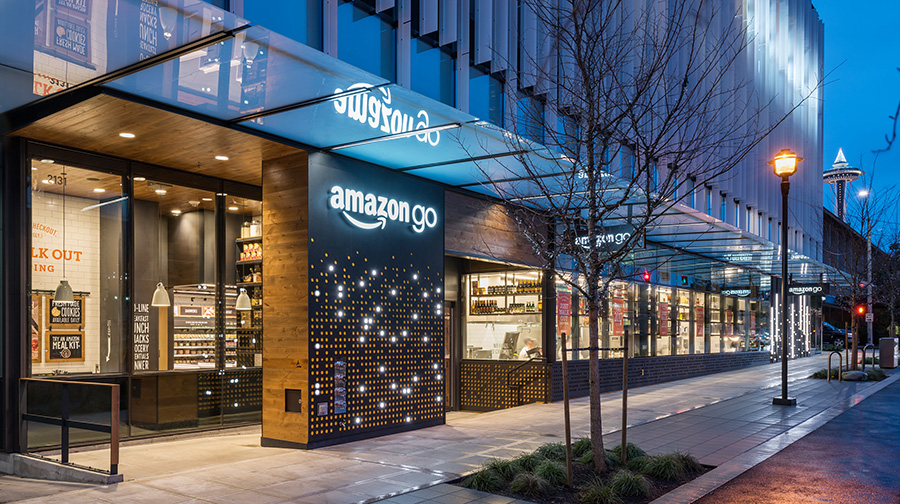By Tom Kaiser
Low margins, enormous overhead, perishable inventory, cutthroat competition and crabby customers are just a few reasons the grocery business isn’t easy. But that’s not deterring Amazon’s most recent example of relentless expansion in its hometown of Seattle.
Rumored to be a subsidiary of its Project Como dedicated to cracking the American grocery store nut, Amazon Go offers customers the breezy convenience of shopping without the hassle of lines or cashiers. Scan your phone when you walk in, grab whatever primary perishable items you like and walk out the door. Forget the dry bulk goods, they can be delivered right to your home.
“Our checkout-free shopping experience is made possible by the same types of technologies used in self-driving cars: computer vision, sensor fusion and deep learning,” Amazon’s description reads. “Our Just Walk Out technology automatically detects when products are taken from or returned to the shelves and keeps track of them in a virtual [Amazon] cart.” (Picture why you don’t move all those little liquor bottles in your hotel’s minibar unless you want to pay for them.)
Rather than the traditional model of using cashiers and scanners to total up a basket of goods, Amazon’s Go stores rely on cameras, an app and augmented reality technology to keep an accurate running total.
According to The Wall Street Journal’s story—largely based on anonymous sources—Go is just one of three Amazon-branded grocery-store formats. The article claims that its next brick-and-mortar concepts will be larger than Go, the first of which is the size of a typical convenience store in an urban environment, and may include drive-thru or curbside pickup capabilities. In addition, the article said Amazon plans to open “more than 2,000 brick-and-mortar grocery stores under its name.”
While the company declined a formal interview, Amazon pushed back against The Wall Street Journal’s story.
“It’s absolutely not correct,” said an Amazon spokesperson about ramping up to 2,000 grocery locations. “We have no plans to open 2,000 of anything. Not even close. We are still learning.” They’re also not considering larger 30,000-40,000 square-foot locations. Its response to the rumored larger storefronts was similarly a tart: “It’s not correct—we have no plans to build such a store.”
Grocery analyst David Livingston of DJL Research, said the most significant innovation with Amazon Go is not needing cashiers, which he said—in conjunction with smaller footprints—could significantly improve the historically slim grocery industry profit margins. He predicted Amazon’s expansion will work its way down the West Coast, with future stores possibly landing in Portland, San Francisco and Los Angeles.
Bill Bishop of Chicago-based Brick Meets Click struck a different note, saying Amazon’s in-store technology will prove to be the most significant advancement for the grocery industry.
“They’ve got technology in terms of product identification and payment and augmented reality all bundled up together [with] inventory planning and assortment,” he said. “I’ve not seen anyone else put together the range and sophistication of technology to reinvent the store shopping experience, and that’s a big deal.”
Bishop said Amazon’s interest in the grocery space is a natural result of the company’s plans to build a sophisticated, end-to-end infrastructure to deliver products to homes, and that the size and frequency of grocery shopping transactions would “fill out their ability to serve a network of households.”
He added that the company’s deep pockets and long-term interest in the category will likely lead to aggressive pricing to attract grocery customers. Even if it succeeds in reaching 5 percent of the American grocery market, he said, Amazon can still have significantly negative impacts on larger grocery brands, many of which have a store network that’s based on 20- to 30-year leases, making it more difficult to right-size stores to shrink overhead costs.
Regarding Amazon’s denial of plans to eventually build 2,000 grocery locations, as has been widely reported, Bishop said that’s not so far fetched if Amazon Go turns out to be a success during initial trials.
“If the consumers like this and these guys can make it work at breakeven or a little bit better, you’re going to see them build a whole bunch [of locations],” he said. “Amazon is great at testing, at deciding very quickly if something new is or isn’t going to work and … very good at pushing forward at things that have worked for them—witness Amazon Prime.”


